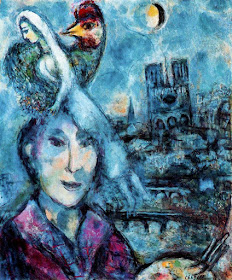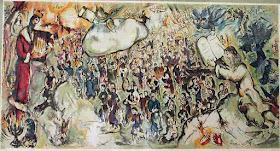 |
| Marc Chagall in his Atelier 1945 |
Marc Zakharovich Chagall (born Moishe Zakharovich Shagalov 1887 - 1985) was a Russian-French artist of Belarusian Jewish origin. An early modernist, he was associated with several major artistic styles and created works in virtually every artistic format, including painting, book illustrations, stained glass, stage sets, ceramic, tapestries and fine art prints.
For more biographical information see part 1, and for earlier works see parts 1-18 also.
This is part 19 of a 28-part series on the works of Marc Chagall:
 |
| 1959-68 Artist at his Easel oil on paper laid down on canvas 55.5 x 49 cm Private Collection |
 |
| 1959-68 Self-Portrait oil on canvas Uffizi Gallery, Florence, Italy |
 |
| 1960 Bateau-Mouche au Bouquet colour lithograph on paper 38.1 x 30.5 cm |
 |
| 1960 Bouquet near the Window oil on canvas Private Collection |
 |
| 1960 Campanules pencil, pastel, gouache and tempera on paper 72 x 52.5 cm |
 |
| 1960 Chagall Lithographs Cover for Volume I lithograph 30.5 x 52.1 cm |
 |
| 1960 Lovers with Red Sun colour lithograph 48.3 x 33 cm |
 |
| 1960 Offering lithograph 31 x 24 cm |
 |
| 1960 Our House, in my Village colour lithograph 32 x 24.1 cm |
 |
| 1960 Paradise colour lithograph 35.6 x 25.3 cm ( image ) |
 |
| 1960 Paradise colour lithograph 37 x 27 cm |
 |
| 1960 Paradise colour lithograph 52.5 x 38 cm ( image ) |
 |
| 1960 Place de la Concorde colour lithograph 38.1 x 30.5 cm |
 |
| 1960 Profile and Red Child colour lithograph on wove paper 31.9 x 24.1 cm ( sheet ) |
 |
| 1960 Quai de la Tournelle colour lithograph on paper 38.1 x 58.4 cm |
 |
| 1960 Self-Portrait colour lithograph on wove paper 31.9 x 24.3 cm ( sheet ) |
 |
| 1960 Still Life with Bouquet colour lithograph on Arches paper 74.3 x 58.1 cm ( sheet ) |
 |
| 1960 The Tree of Jesse oil on canvas 33 x 24.1 cm |
 |
| 1960 The Tree of Jesse colour lithograph 32 x 25 cm ( sheet ) |
 |
| 1960 The Angel colour lithograph 32 x 24.5 cm |
 |
| 1960 The Circus lithograph 32 x 24.5 cm |
 |
| 1960 The Eiffel Tower Lovers colour lithograph on Arches Wove paper 66.5 x 50.5 cm ( sheet ) |
 |
| 1960 Vision of Paris colour lithograph 29.6 x 21.5 cm ( image ) |
 |
| 1960c Circus Woman colour lithograph and stencil 79.7 x 63.8 cm ( sheet ) |
 |
| 1960c Meditation oil, gouache, pastel and charcoal on paper laid down on paper 58.5 x 45.7 cm Private Collection |
 |
| 1960c Platter of Fruit pencil, oil, pan and black ink on panel 13.3 x 18.1 cm Private Collection |
 |
| 1961 Galerie Maeght poster, Paris colour lithograph |
 |
| 1961 Couple with Sled at Sils gouache and pastel on paper 65.6 x 47.8 cm Private Collection |
1959-61 The Twelve Tribes
Stained Glass Window designs:
In 1959, Dr. Mariam Freund (National President of the Hadassah) and
Joseph Neufeld (architect who designed the Hadassah-Hebrew University Medical
Center) commissioned Marc Chagall to design the stained-glass windows for the
synagogue that was to be part of the medical center. Each of the twelve windows
would represent one of the twelve tribes of Israel. Chagall worked on the
project for two years, with the windows ultimately exhibited in Paris in June
of 1961 and at the Museum of Modern Art New York in the winter of 1961. In
February 1962, they were permanently installed in the synagogue. Chagall
created the lithographic series The Twelve Maquettes for the Stained Glass
Windows for Jerusalem after the image of these original stained glass windows.
The twelve tribes of Israel represent the twelve kin groups of ancient
Israel, who are each traditionally descended from one of the twelve sons of
Jacob: Reuben, Simeon, Levi, Judah, Dan, Naphtali, Gad, Asher, Issachar,
Zebulun, Joseph, and Benjamin. Upon Jacob’s death, the territory of Israel was
divided amongst his twelve sons, designating the twelve tribes of Israel.
 |
| 1959 The Twelve Tribes Tribe of Dan |
 |
| 1959 The Twelve Tribes Tribe of Binyamin |
 |
| 1959 The Twelve Tribes Tribe of Shimon |
 |
| 1959 The Twelve Tribes Tribe of Asher |
 |
| 1959 The Twelve Tribes Tribe of Gad |
 |
| 1959 The Twelve Tribes Tribe of Issachar |
 |
| 1959 The Twelve Tribes Tribe of Joseph ( Yosef ) |
 |
| 1959 The Twelve Tribes Tribe of Levi |
 |
| 1959 The Twelve Tribes Tribe of Reuben |
 |
| 1959 The Twelve Tribes Tribe of Yehuda ( Judah ) |
 |
| 1959 The Twelve Tribes Tribe of Zevulun |
 |
| 1959 The Twelve Tribes Tribe of Naphtali |
 |
1962 Set of 12 lithographs of The Twelve Tribes designs:
 |
| 1962 The Twelve Tribes lithograph designs |
 |
| 1962 The Twelve Tribes lithograph designs |
 |
| 1962 The Twelve Tribes lithograph designs |
These two sets of lithographs date from 1962 - In each case I have shown what I believe was a more sketchy version of a second more (finished) set:
 |
| c1962 The Twelve Tribes Tribe of Asher colour lithograph |
 |
| 1962 The Twelve Tribes Tribe of Asher colour lithograph 32.5 x 24.5 cm |
 |
| c1962 The Twelve Tribes Tribe of Dan colour lithograph |
 |
| 1962 The Twelve Tribes Tribe of Dan colour lithograph 32.5 x 24.5 cm |
 |
| c1962 The Twelve Tribes Tribe of Gad colour lithograph |
 |
| 1962 The Twelve Tribes Tribe of Gad colour lithograph 32.5 x 24.5 cm |
 |
| c1962 The Twelve Tribes Tribe of Issachar colour lithograph |
 |
| 1962 The Twelve Tribes Tribe of Issachar colour lithograph 32.5 x 24.5 cm |
 |
| c1962 The Twelve Tribes Tribe of Reuben colour lithograph |
 |
| 1962 The Twelve Tribes Tribe of Reuben colour lithograph 32.5 x 24.5 cm |
 |
| c1962 The Twelve Tribes Tribe of Shimon ( Simeon ) colour lithograph |
 |
| 1962 The Twelve Tribes Tribe of Shimon ( Simeon ) colour lithograph 32.5 x 24.5 cm |
 |
| c1962 The Twelve Tribes Tribe of Yehuda ( Judah ) colour lithograph |
 |
| 1962 The Twelve Tribes Tribe of Yehuda ( Judah ) colour lithograph 32.5 x 24.5 cm |
 |
| c1962 The Twelve Tribes Tribe of Zevulun colour lithograph |
 |
| 1962 The Twelve Tribes Tribe of Zevulun colour lithograph 32.5 x 24.5 cm |
1960-68 The Chagall State Hall, The Knesset,
Jerusalem:
The Chagall state hall is used for state receptions. The hall was
designed and decorated by the Jewish artist Marc Chagall (1887-1985). Chagall
designed for the hall 12 floor mosaics, one wall mosaic and three Gobelin
tapestries.
Speaker of the Knesset Kadish Luz called on March
Chagall in 1960 and requested that he provide the artwork the future permanent
Knesset building. It was first discussed that he create murals or works of
stained glass, as he had created for the synagogue at the Hadassah Hospital.
Chagall, however, wished to attempt to create tapestries. Kadish Luz provided him with passages from the Bible, and
Chagall worked them into his drawings. In December 1963 he suggested to make
the Gobelins as a triptych – three paintings of the same theme, hanging
side-by-side and comprising a whole.
Chagall made the original paintings the same size of the future tapestries. The painting for the right tapestry was completed at the end of 1963, since he had made a similar painting – in different colors – for a stained glass window he made for the United Nations building in memory of the late Secretary General Dag Hammarskjöld.
Chagall made the original paintings the same size of the future tapestries. The painting for the right tapestry was completed at the end of 1963, since he had made a similar painting – in different colors – for a stained glass window he made for the United Nations building in memory of the late Secretary General Dag Hammarskjöld.
The paintings
for the centre and left tapestries were completed in the summer of 1964. It was
then that the weaving of the tapestries began, at the “Atelier de la
Manufacture des Gobelins” workshop in Paris. Prior to the work on the
tapestries themselves, the workshop attempted weaving portions of the carpets
for a year and selected 144 colours and shades to be used in their making. The
weaving began in 1965 and continued until early 1968.
The side tapestries are
4.8 meters high and 5.5. meters wide, and the centre is 4.8 meters high and 9.5
meters wide. Each tapestry was signed by the company and shows the signature of
Chagall and the date of the painting. They were hung on June 18th 1969, in the
presence of the President of the State.
 |
 |
 |
 |
 |
 |
 |

